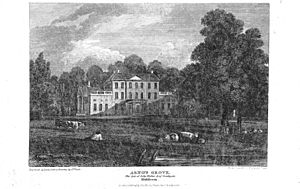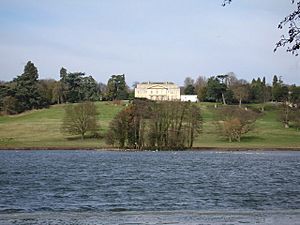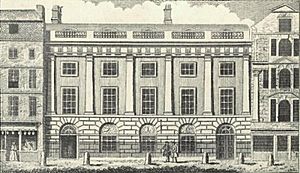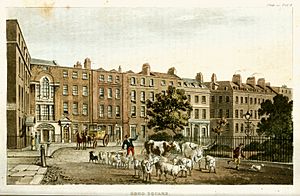George Colebrooke facts for kids
Sir George Colebrooke, 2nd Baronet (born 14 June 1729 – died 5 August 1809) was an important English banker and politician. He lived at Gatton in Surrey. Sir George was a Member of Parliament (MP) for Arundel from 1754 to 1774. He also served as the chairman of the powerful East India Company from 1767 to 1772.
Colebrooke was known for his great wealth and his love for showing it off. He was also very ambitious and took big risks with his money. People called him a stockjobber (someone who buys and sells shares) and a Nabob (a wealthy person who made their fortune in India). He was closely connected to famous figures like Robert Clive. Sadly, Colebrooke lost all his money because of bad investments during a financial crisis in 1772.
Contents
Early Life and Family
George Colebrooke was born in 1729 in Chilham, Kent. He was the third son of James Colebrooke, a successful banker in London. George studied at Leiden University around 1745. When his father passed away in 1752, George inherited Arnos Grove house.
His older brothers were Robert and James Colebrooke. James bought control of a parliamentary seat in a "rotten borough" called Gatton for a lot of money. A rotten borough was an old term for a place that had very few voters but still had a Member of Parliament. This meant a rich person could easily control who became an MP there.
In 1759, James was given a special title called a baronetcy. This title could be passed down to George. When James died, George inherited the baronetcy, Gatton Park, and control of one of Gatton's parliamentary seats. He even hired a famous landscape designer, Capability Brown, to work on Gatton Park.
Sir George's Career
In 1761, George took over the family bank in Threadneedle Street, London. He used some of his wealth to gain influence over the borough of Arundel in Sussex. Arundel was a corrupt borough where bribery was common to win elections. Colebrooke managed to control elections there for twenty years. He himself was Arundel's MP from 1754 to 1774. For most of this time, he could also choose who held the other parliamentary seat for Arundel.
Colebrooke's support for the government helped him get valuable contracts. By 1762, he had two important contracts. One was for sending money to British soldiers in the American colonies. The other was for supplying food to the troops there. However, when the government changed, he lost these contracts. He later accepted a well-paid job as a chirographer (a clerk who recorded legal documents) for the Court of Common Pleas. After this, he was rarely active in Parliament, even though he kept his seat.
In 1764, he became a partner in a bank in Dublin. Colebrooke had many different business interests. He bought large pieces of land in Lanarkshire, Scotland. He also purchased plantations in Antigua, Grenada, and Dominica in the Caribbean. He owned enslaved people on these plantations. He was also part of a group that planned to settle the Ohio Valley in America in 1768. Colebrook, New Hampshire is named after him.
Two of his biggest business interests, however, led to his financial ruin. These were his involvement with the British East India Company and his risky investments in raw materials.
Financial Troubles in 1773

Colebrooke was a full-time Director of the East India Company from 1767 to 1771. He was also Deputy Chairman from 1768 to 1769. He was elected Chairman three times: in 1769, 1770, and 1772. His last year as chairman was very difficult. The East India Company faced serious financial problems. This led to a new law called the Regulating Act of 1773.
Colebrooke was accused of making risky investments in the company's shares while he was chairman. He also ended up deeply in debt to other important figures in the company. He lost even larger amounts of money by speculating on raw materials like hemp, flax, lead, and alum. For example, in 1771, he lost £190,000 dealing in hemp. From 1772, he tried to control the world's supply of alum by buying mines. But the market for alum collapsed as part of the financial crisis of 1772. This swallowed up most of his remaining fortune.
At first, the Bank of England helped Colebrooke stay in business. But his bank temporarily stopped payments on 31 March 1773. It closed permanently on 7 August 1776. Most of his property, including his share in the Gatton borough and his art collection, was sold in 1774 to pay his debts. Despite this, he spent a lot of money rebuilding his London house at 32 Soho Square. This mansion was later sold in 1779.
Later Life
Between 1777 and 1778, Sir George Colebrooke moved to Boulogne-sur-Mer in France. He was so poor that the East India Company had to give him a pension. He later moved to Soissons. In 1789, during the French Revolution, he returned to England. Eventually, he managed to pay all his creditors (people he owed money to) in full. This meant some inheritance was left for his children. He also played an important role in Bath, Somerset, especially in helping charities.
Marriage and Children
Sir George Colebrooke married Mary Gayner in 1754. Mary was the daughter of Peter Gayner from Antigua. They had three sons and three daughters:
- Mary Colebrooke (born 1757)
- George Colebrooke (1759–1809)
- James Edward Colebrooke (1761–1838), who inherited his father's baronetcy
- Harriet Colebrooke (1762–1785)
- Louisa Colebrooke (born 1764)
- Professor Henry Thomas Colebrooke (1765–1837)
He also helped raise his brother James's two daughters, Mary and Emma Colebrook, from 1761 until they were married.






